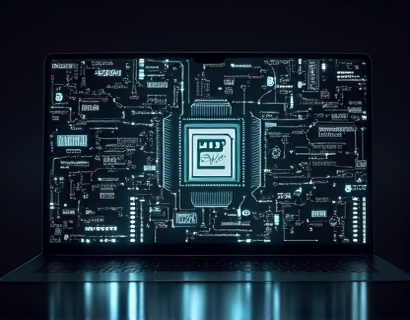Crypto-Powered Digital Transformation: Leveraging AI for Enhanced Ucosystem Engagement
The digital landscape is undergoing a profound transformation, driven by the convergence of cryptocurrency and artificial intelligence (AI). This shift is not merely a technological evolution but a paradigm change that is redefining how businesses interact with users. In this comprehensive guide, we explore the intricate ways in which crypto-powered digital transformation, coupled with AI, can revolutionize user engagement within the Ucosystem. This article is designed for tech enthusiasts, professionals, and businesses looking to harness these advanced technologies to stay competitive and innovative.
Understanding Crypto-Powered Digital Transformation
Crypto-powered digital transformation refers to the integration of blockchain technology and cryptocurrencies into business processes and user engagement strategies. This integration brings several key advantages, including enhanced security, transparency, and decentralization. By leveraging cryptocurrencies, businesses can create more resilient and trustworthy systems, reducing the risk of fraud and increasing user confidence.
One of the primary drivers of this transformation is the decentralized nature of blockchain. Traditional centralized systems are vulnerable to single points of failure and censorship. In contrast, blockchain's distributed ledger technology ensures that data is stored across multiple nodes, making it highly secure and tamper-proof. This level of security is crucial for building trust with users, especially in sectors like finance, healthcare, and supply chain management.
AI: The Catalyst for Smart User Engagement
Artificial intelligence plays a pivotal role in enhancing user engagement by providing personalized and context-aware experiences. AI algorithms can analyze vast amounts of data to understand user behavior, preferences, and needs. This insight enables businesses to tailor their offerings and interactions, creating a more seamless and satisfying user experience.
For instance, AI-driven chatbots can provide 24/7 customer support, answering queries and resolving issues in real-time. These chatbots can be powered by natural language processing (NLP) to understand and respond to user inputs more effectively. Additionally, AI can optimize content delivery, ensuring that users receive the most relevant information at the right time, thereby increasing engagement and loyalty.
Synergizing Crypto and AI for Ucosystem Engagement
The true power of crypto-powered digital transformation is unleashed when combined with AI. This synergy creates a robust framework for enhancing user engagement and driving business growth. Here’s how businesses can leverage this combination to transform their Ucosystem:
1. Decentralized Reward Systems
One of the most innovative applications of crypto in user engagement is the creation of decentralized reward systems. These systems use tokens, often based on blockchain technology, to incentivize user participation and loyalty. AI can optimize these reward mechanisms by analyzing user behavior and preferences to distribute tokens in a way that maximizes engagement and retention.
For example, a platform could use AI to identify high-engagement users and reward them with tokens that can be redeemed for premium services or products. This not only encourages continued engagement but also fosters a sense of community and ownership among users.
2. Enhanced Data Privacy and Security
Data privacy is a growing concern for users, and crypto technology offers robust solutions to enhance data security. By using blockchain, businesses can create immutable and transparent records of user data transactions. AI can further enhance this by implementing advanced encryption and anonymization techniques, ensuring that user data is protected from unauthorized access and breaches.
Moreover, AI-driven security systems can detect and respond to potential threats in real-time, providing an additional layer of protection. This combination of crypto and AI not only builds trust but also complies with stringent data protection regulations, such as GDPR and CCPA.
3. Personalized User Experiences
Personalization is key to user engagement in the digital age. AI algorithms can analyze user data to create highly personalized experiences, from tailored content recommendations to customized product offers. When combined with crypto, these experiences can be further enhanced through token-based incentives.
For instance, a streaming service could use AI to curate a personalized playlist based on a user’s listening history and preferences. To incentivize continued use, the service could offer tokens that users can earn and redeem for exclusive content or discounts. This dual approach not only keeps users engaged but also creates a virtuous cycle of interaction and reward.
4. Smart Contracts for Automated Engagement
Smart contracts, self-executing contracts with the terms directly written into code, can automate various aspects of user engagement. By integrating AI with smart contracts, businesses can create dynamic and responsive systems that adapt to user behavior in real-time.
For example, a loyalty program can use smart contracts to automatically award tokens to users based on their activities, such as referrals, purchases, or content creation. AI can optimize the conditions and rewards within these smart contracts to ensure they remain attractive and effective over time.
5. Predictive Analytics for Proactive Engagement
AI-driven predictive analytics can forecast user behavior and preferences, enabling businesses to proactively engage users before they even realize their needs. By analyzing historical data and real-time insights, AI can identify patterns and trends that inform strategic decisions.
For instance, a retail platform can use predictive analytics to anticipate which products a user is likely to purchase next and proactively offer personalized recommendations or special offers. This proactive approach not only enhances the user experience but also drives sales and customer loyalty.
Challenges and Considerations
While the potential benefits of crypto-powered digital transformation and AI are significant, businesses must also be aware of the challenges and considerations involved:
1. Regulatory Compliance
The crypto space is still largely unregulated, and compliance can be a complex issue. Businesses must navigate varying regulations across different jurisdictions to ensure they are operating within legal boundaries. AI can help by providing tools to monitor and manage compliance, but it is essential to stay informed about regulatory developments.
2. Technical Complexity
Integrating blockchain and AI requires a high level of technical expertise. Businesses need to invest in skilled personnel or partner with experts to develop and maintain these systems. Additionally, ensuring interoperability between different blockchain platforms and AI frameworks can be challenging but is crucial for a seamless user experience.
3. User Education
Many users are still unfamiliar with cryptocurrency and blockchain technology. Educating users about the benefits and functionalities of crypto-powered features is essential for adoption. AI can assist in creating intuitive and informative user interfaces that guide users through the process, reducing friction and enhancing the overall experience.
Case Studies and Real-World Applications
To better understand the practical applications of crypto-powered digital transformation and AI, let’s explore a few real-world examples:
1. Decentralized Finance (DeFi)
DeFi platforms leverage blockchain and AI to provide financial services without traditional intermediaries. These platforms use AI to optimize trading strategies, manage risks, and personalize financial products. For instance, a DeFi lending platform can use AI to assess creditworthiness and set interest rates dynamically, enhancing both security and user experience.
2. Digital Identity Verification
Crypto and AI can revolutionize digital identity verification, providing secure and user-controlled identity solutions. AI algorithms can analyze biometric data and other identifiers to verify user identities with high accuracy. Blockchain ensures that these identities are stored securely and can be managed by the users themselves, reducing the risk of identity theft and fraud.
3. Supply Chain Transparency
In supply chain management, blockchain provides a transparent and immutable record of transactions, while AI can optimize logistics and predict potential bottlenecks. For example, a company can use AI to analyze supply chain data and identify areas for improvement, such as reducing transportation times or minimizing waste. Tokens can be used to incentivize suppliers and partners who meet specific quality and efficiency standards.
Future Trends and Opportunities
The intersection of crypto, AI, and digital transformation is an evolving landscape with numerous opportunities for innovation. Here are some future trends to watch:
1. Increased Adoption of Central Bank Digital Currencies (CBDCs)
Central banks around the world are exploring CBDCs, which combine the benefits of blockchain with fiat currency. AI can play a crucial role in managing and optimizing CBDC systems, ensuring security, efficiency, and user accessibility.
2. Enhanced Cross-Chain Interoperability
As the number of blockchain platforms grows, the need for cross-chain interoperability becomes increasingly important. AI can help develop solutions that enable seamless interaction between different blockchain networks, fostering a more interconnected and efficient ecosystem.
3. Integration with Internet of Things (IoT)
The convergence of blockchain, AI, and IoT is opening new possibilities for smart cities, smart homes, and industrial automation. AI can process and analyze data from IoT devices, while blockchain ensures secure and transparent data sharing. Tokens can be used to incentivize participation and optimize resource usage.
Conclusion
The integration of crypto and AI is transforming the digital landscape, offering unprecedented opportunities for businesses to enhance user engagement and drive growth. By embracing these technologies, companies can create more secure, personalized, and efficient Ucosystems. As the tech landscape continues to evolve, staying informed and adaptable will be key to success in the crypto and AI era.











































